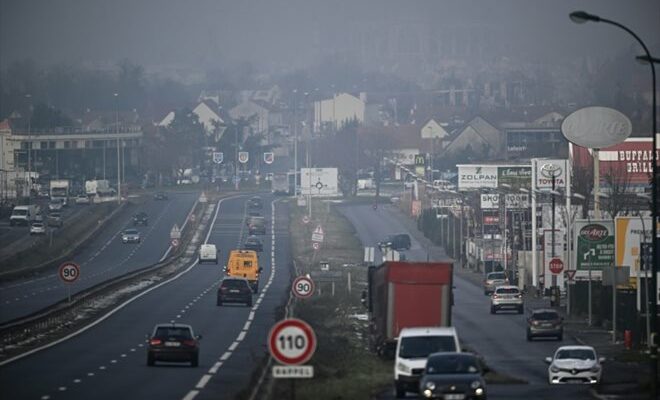The entrance to the town of Meaux via the D360 road offers a view of the Gothic Saint-Etienne de Meaux cathedral, January 19, 2024 (AFP/JULIEN DE ROSA)
Coming off the D360, the top of a hill suddenly reveals a magnificent panorama of Meaux, its Gothic cathedral, and the surrounding hilly countryside. A bucolic perspective bordered, on each side of the road, by the familiar jumble of ZAC signs at the town entrance.
Hypermarkets, all-you-can-eat Chinese buffets, American fast-food restaurants, DIY or household appliance chains, car dealerships… nothing is missing.
At the southern entrance to the most populated commune of Seine-et-Marne, this concerted development zone is typical of these commercial spaces emblematic of the consumer society, sometimes vilified for their appearance and their economic model, which have burgeoned on the outskirts of French cities since the 1970s.
Getting out of her car to walk the few meters that separate it from the C&A, Marlène Mouketo goes there every three weeks in a hurry to “the clothing stores, the trinkets stores, sometimes the McDonald’s…”
“There is a shortage in the city center. All the stores have gone, there is not much left inside,” regrets this fifty-year-old who has lived in Meaux for a quarter of a century.
Despite the criticism, this customer finds these ZACs very “practical”: “if you have to travel 40 kilometers to find a piece of clothing, it’s not worth it. Otherwise we order everything on the internet. It’s perhaps not good for the fields, it’s not eco-friendly, but it’s good for us.”
In the 1980s there was still agricultural land here. Only two supermarkets faced each other around a roundabout, with a small shopping arcade, a gas station…
Today, nearly 400 establishments are concentrated on the 95 hectares of this ZAC, mainly businesses. The place alone brings together 5% of all active businesses in the Pays de Meaux intermunicipality, with 26 municipalities and 110,000 inhabitants.
– “Place of life” –
Director of the “sports bar” of the Au Bureau chain, which replaced a Pizza Hut at the end of 2020, Mickael Boutry sees in this ZAC an authentic “place to live” for the region.
In its “London pub” decor, seniors come to have tea, families enjoying a pancake or young people gathered in front of the evening match with a beer in hand.

The ZAC of Nanteuil-les-Meaux along the D360, January 19, 2024 (AFP/JULIEN DE ROSA)
“We can have a little noisier entertainment, we are not stuck to the houses like in the city center (…) Here we can have a DJ evening without disturbing anyone,” says the 32-year-old restaurateur.
This ZAC, the largest of the three located at the different entrances to Meaux, has established itself as a major economic center in the region.
In addition to part of the 55,000 inhabitants of Meaux, it attracts consumers from the entire southern basin of the agglomeration, made up of rural villages and small suburban towns with poor or even non-existent commercial offerings. Here, you can shop without entering the city itself.
“In the villages, people will have a bakery in the best case scenario (…) But as soon as we want to equip ourselves, we have to come to Meaux,” describes Franck Gourdy, the vice-president in charge of development economy of the Pays de Meaux.
“We are really focusing on local consumption,” he believes, “even though these ZACs are large, it is people who do not live very far away who are the main consumers.”
In a bakery, a customer redeems a voucher for her birthday. When leaving classes or offices, the gyms fill up with sweaty young people. A family comes to buy soccer equipment for their 8-year-old.
– Queen car –
The two “locomotive” of the ZAC are two hypermarkets Leclerc and Carrefour. Their customers take the opportunity to visit neighboring stores or for a restaurant outing.
“When we do our shopping and go out late, we say to ourselves, ‘Hey, we’re going to eat at the restaurant’,” say a retired couple, Colette and Bernard, while pushing their shopping cart.

The ZAC of Nanteuil-les-Meaux along the D360, January 19, 2024 (AFP/JULIEN DE ROSA)
In the row of asphalt parking lots and prefabricated warehouse stores, few pedestrians.
Here, the car is king and even constitutes a major commercial argument. “We can park without any problem, we don’t pay for the parking space, we go from one store to another,” relishes Dominique, a security guard who did not wish to give her last name.
Between the Lidl and the Burger King, a strange ghost village has been established, populated by around fifteen model houses. No need to knock: everyone can enter at their leisure and tour the future owner.
Installed all week in a peach-colored house “5 rooms, 110 m2 of living space, with garage”, Agathe Fourgeot sees in this location in the middle of a ZAC a golden opportunity for the notoriety of the small Seine-et-Marne builder that she represents .
When a place became available in this exhibition village, “it was the Holy Grail, we joined the big manufacturers,” relates the 27-year-old young woman.
Aware of the criticism of the ugliness of the ZACs and their dependence on all-car use, the Pays de Meaux intermunicipality intends to develop the bus network there, install cycle paths and facilitate carpooling. Overall aesthetics are also given more consideration.
“Today, on each project, attention is focused on exterior aspects, in particular revegetation and integration into the landscape. These concerns were not there at all at the beginning,” says Franck Gourdy, “but do something harmonious about things that have been there for thirty or forty years, it’s complicated.”
© 2024 AFP
Did you like this article ? Share it with your friends using the buttons below.




